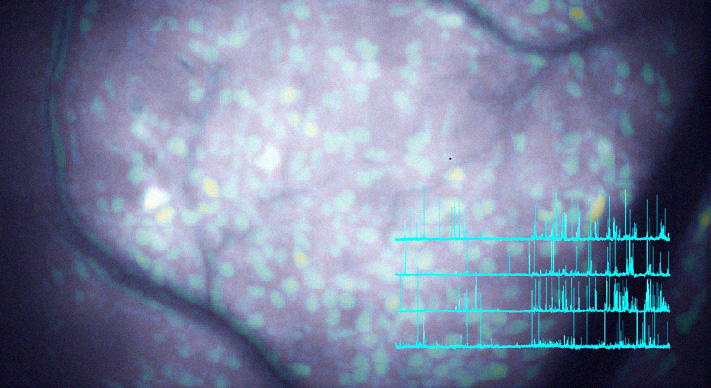Paper details
L-DOPA is the reference treatment of Parkinson’s disease (PD). However, its chronic administration induces abnormal involuntary movements termed L-DOPA-induced dyskinesia (LID). The striatum has a pivotal role in generating PD and LID. PD is related to overactivity of the striatal projection neurons of the “indirect pathway” (iSPN) over the “direct pathway” neurons (dSPN). Conversely, LID is associated with a predominant role of dSPN over iSPN. However, the population dynamics of both SPNs to the generation of these movement disorders is poorly understood.
Using in vivo calcium imaging in freely-moving mice, we aimed to identify patterns of striatal SPN activities coding for akinesia and dyskinesia in a mouse model of PD and LID. We used D1-Cre and A2a-Cre transgenic mice to express the calcium indicator GCamp6f in dSPN and iSPN, respectively. Mice were also implanted with accelerometers to record motor activity while imaging striatal activity in vivo in an open field. We measured simultaneously motor and neural activity in intact and PD mice at baseline and after administration of dopamine agonists as D1- and D2-agonists and L-DOPA.

Our data show that calcium activity of both SPNs increases with movement in intact and PD mice. We found a positive correlation between calcium signal activity and body acceleration that was, interestingly, lost after administration of L-DOPA and dopamine agonists. Administration of L-DOPA, which induces dyskinesia, dramatically increased dSPNs activity while significantly decreasing iSPNs activity.
To correlate neural activity with specific pathological movements, we developed tools that combine the usage of accelerometers and artificial intelligence. We clustered mice behaviour using an unsupervised machine learning algorithm and we classified dyskinetic movements with a supervised deep-learning approach. Using these two approaches, we were able, for the first time, to identify dyskinetic behaviour automatically. We found specific behavioural clusters appearing only after L-DOPA treatment which were associated with distinct maps of dSPN and iSPN population activities.
References:
1 Alcàcer C, Andreoli L, Sebastianutto I, Jakobsson J, Fieblinger T, and Cenci MA. Chemogenetic stimulation of striatal projection neurons modulates responses to Parkinson's therapy. J Clin Invest. 2017 Feb 1;127(2):720-734. (Impact Factor: 14.434, Citations: 57).2 Alcàcer C, Santini E, Valjent E, Gaven F, Girault JA, Hervé D. Gα(olf) mutation allows parsing the role of cAMP-dependent and extracellular signal-regulated kinasedependent signaling in L-3,4-dihydroxyphenylalanine-induced dyskinesia. J Neurosci. 2012 Apr 25;32(17):5900-10. (Impact Factor: 6.673, Citations: 77).
3 Santini E, Alcàcer C, Cacciatore S, Heiman M, Hervé D, Greengard P, Girault JA, Valjent E, Fisone G. L-DOPA activates ERK signaling and phosphorylates histone H3 in the striatonigral medium spiny neurons of hemiparkinsonian mice. J Neurochem. 2009 Feb; 108 (3): 621-33. (Impact Factor: 4.870; Citations: 169).


